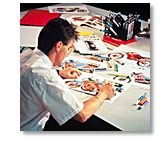
Today Ugolini Global Design owns two autonomous yet complementary design centres, one in Rimini (since 1988) and one in Milan (since 1996). Together they cover 1300 sq.m., employ 30 specialist designers and design 
“Even when I was at Bologna University”, says Ugolini, “I knew exactly what I intended to do: custom-tailored design for clients.
I actually won my degree by designing the Tesi moped, a revolutionary prototype created for Bimota in Rimini and still in production. But it was Leonardo Fioravanti and later Lorenzo Ramaciotti who really set me alight. It was during a period of study in Pininfarina that I learned how to marry inspiration to practicality. And on that basis I set up the Ugolini Studio in 1988.”
So he was off on the great adventure, at first mostly working for motorcycle manufacturers (not just Bimota, but also Cagiva and Honda Europa). Opening the Milan premises broadened his horizons. First he established relations with big firms in Italy and then found that some of the big international players were showing an interest. But he always had a clear-cut plan in mind: to offer creative work plus engineering.
Ugolini explains his philosophy as follows: “What we call it hardly matters. What we offer is a total design partnership and not just industrial design. We work in interdisciplinary teams, starting with market analysis and then following the entire process through, sometimes even taking total responsibility for the product, right down to die management if that’s needed. It’s a bit like Giugiaro did with cars twenty years ago. Without wishing to appear presumptuous, I think “industrial design” is too restrictive a term for what we do. What we do have is agility that can help us work miracles and have fun at the same time”.
“What restricts large-scale operations”, he explains, “is that they often care more about the label than the substance. What I mean is that the artistic interpretation of the article assumes greater importance than its function. So that you end up with products that are designed for emotional impact, not for use. There’s far too much styling around. By contrast, we start out by eliminating the aesthetic factor. We begin by imagining the object and then we explain it and how it would be made, without giving our customer any idea of what it would look like. It’s only later when we’ve proved that it works that we unveil and fine-tune the look of the thing”.
The article continues in Auto & Design no. 115










